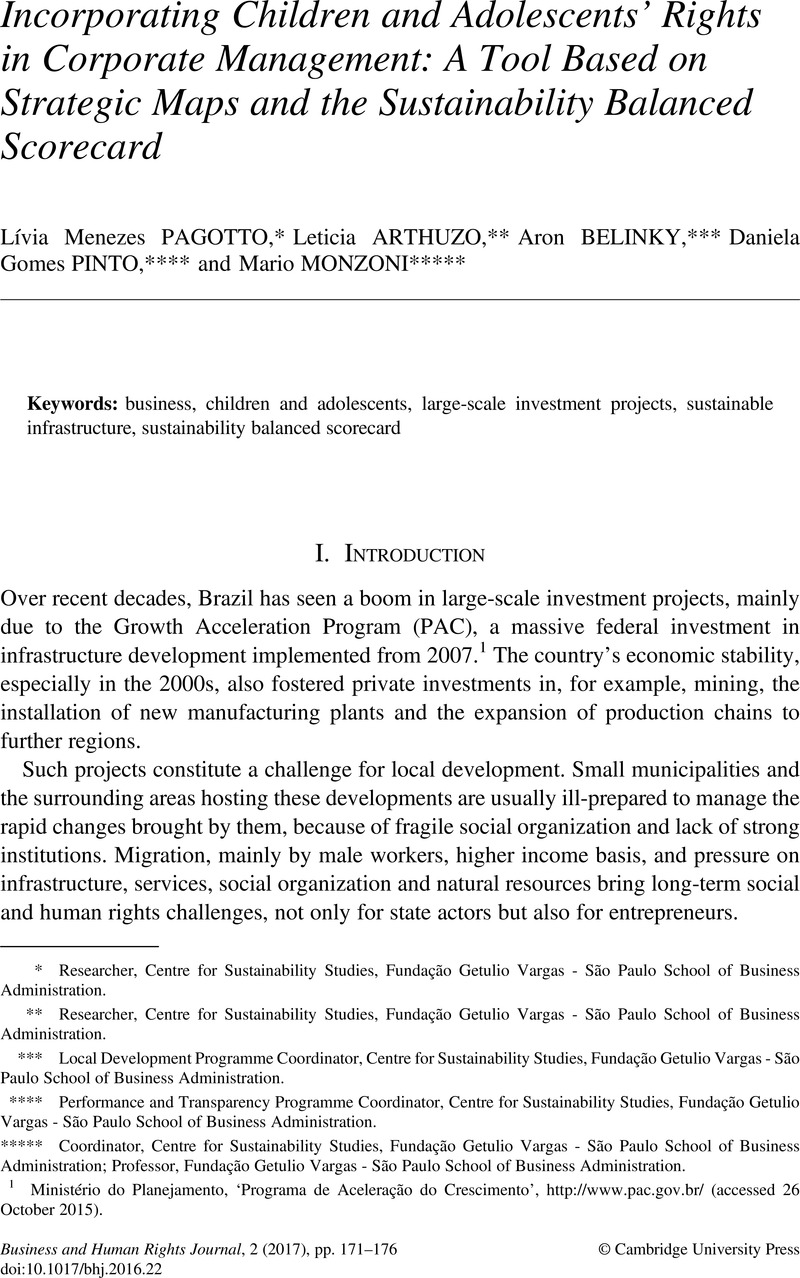Article contents
Incorporating Children and Adolescents’ Rights in Corporate Management: A Tool Based on Strategic Maps and the Sustainability Balanced Scorecard
Published online by Cambridge University Press: 31 August 2016
Abstract

Keywords
- Type
- Developments in the Field
- Information
- Copyright
- Copyright © Cambridge University Press
Footnotes
Researcher, Centre for Sustainability Studies, Fundação Getulio Vargas - São Paulo School of Business Administration.
Researcher, Centre for Sustainability Studies, Fundação Getulio Vargas - São Paulo School of Business Administration.
Local Development Programme Coordinator, Centre for Sustainability Studies, Fundação Getulio Vargas - São Paulo School of Business Administration.
Performance and Transparency Programme Coordinator, Centre for Sustainability Studies, Fundação Getulio Vargas - São Paulo School of Business Administration.
Coordinator, Centre for Sustainability Studies, Fundação Getulio Vargas - São Paulo School of Business Administration; Professor, Fundação Getulio Vargas - São Paulo School of Business Administration.
References
1 Planejamento, Ministério do, ‘Programa de Aceleração do Crescimento’, http://www.pac.gov.br/ Google Scholar (accessed 26 October 2015).
2 Brazilian Child and Adolescents Statute (ECA) 1990, Law # 8,069/90. The ECA regulates Art. 227 of the Federal Constitution, which mentions Children’s Rights in Brazil.
3 GVces, ‘Generating Shared Value From Full Protection of Children and Adolescents: Proposition for Business Guidance Under the Context of Large Projects’, https://s3-sa-east-1.amazonaws.com/arquivos.gvces.com.br/arquivos_gvces/arquivos/296/IDLocal2013_English.pdf (accessed 20 November 2015).
According to specialists from the Fundação Getulio Vargas Law School, these court decisions were based on the following criteria: (i) the existing level of economic influence/dependence between the companies; (ii) exclusivity of production from the contracted party to the contracting party; (iii) same economic goal; (iv) belonging to the same production chain; (v) lack or existence of inspections to check working conditions in the contracted companies; (vi) competitive economic edge (compared to the market price of the goods) obtained from slave labour.
4 The proposed management tool was created in 2013 by the Centre of Sustainability Studies of Fundação Getulio Vargas (GVces), in partnership with the Business and Human Rights Group, from GV Law School SP, and Childhood Brazil along with a group of 17 large companies.
5 Kaplan, Robert and Norton, David, Strategy Maps: Converting Intangible Assets into Tangible Outcomes, 5th edn. (Elsevier, 2004)Google Scholar.
6 For different SBSC approaches, see Figge, Frank et al, ‘The Sustainability Balanced Scorecard’ (2002) 11 Business Strategy and the Environment 269–284 CrossRefGoogle Scholar.
7 GVces, ‘Generating Shared Value From Full Protection of Children and Adolescents: Proposition for Business Guidance Under the Context of Large Projects’, https://s3-sa-east-1.amazonaws.com/arquivos.gvces.com.br/arquivos_gvces/arquivos/296/IDLocal2013_English.pdf (accessed 20 November 2015).
8 The city of Altamira is home to Belo Monte Dam, one of the world’s largest hydroelectric dam complexes.
9 United Nations Human Rights, ‘Guiding Principles on Business and Human Rights: Implementing the United Nations “Protect, Respect and Remedy” Framework’, http://www.ohchr.org/Documents/Publications/GuidingPrinciplesBusinessHR_EN.pdf (accessed 27 November 2015).
10 The importance of polycentric governance for the UN Guiding Principles on Business and Human Rights is highlighted in: John Ruggie, ‘Global Governance and “New Governance Theory”: Lessons from Business and Human Rights’ (2014) 20 Global Governance 5–17.
11 Two main UNICEF’s publications have highlighted the relationship between business and children’s rights: Children's Rights and Business Principles (2012) and Children are Everyone’s Business: Workbook 2.0 (2013).
12 The Bunge Foundation and Klabin joined the group of 17 companies that participated in the process of developing the corporate guidelines and management tool (Balanced Scorecard) during 2013 and 2014. Both organizations had their management practices published in the document ‘Generating Shared Value From Full Protection of Children and Adolescents’ (GVces, ‘Generating Shared Value From Full Protection of Children and Adolescents: Proposition for Business Guidance Under the Context of Large Projects’, http://www.idlocal.com.br/generating-shared-value-from-full-protection-of-children-and-adolescents-id-local-2014-cycle?locale=en (accessed 20 November 2015). For the present piece, the information about the cases and their developments in 2015/2016 were updated by: (i) phone interviews with the Bunge Foundation’s Director and a Project Manager and with Klabin’s Sustainability Manager and; (ii) documentary review of recent developments related to the practices implemented by both organizations between 2014 and 2016, i.e., evidence of corporate policies, processes and tools.
13 Klabin is a signatory of the ‘United Nations Global Compact and the Brazilian Pact to Eradicate Slave Labor’. Moreover, two corporate policies had special clauses regarding children and adolescents’ rights protection introduced in their scope: the Code of Conduct and the Suppliers Policy.
- 1
- Cited by




